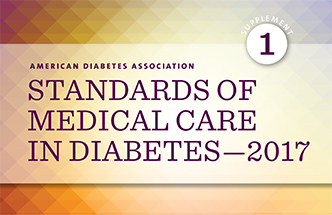
1. ADA publishes ADA Clinical Practice Recommendations 2017 |

![]() Psychological health, access to care, expanded and personalized treatment options, and tracking of hypoglycemia in people with diabetes are key areas emphasized in the American Diabetes Association’s (Association) new 2017 Standards of Medical Care in Diabetes. Some of the revisions made to the existing guidelines are as follows:
Psychological health, access to care, expanded and personalized treatment options, and tracking of hypoglycemia in people with diabetes are key areas emphasized in the American Diabetes Association’s (Association) new 2017 Standards of Medical Care in Diabetes. Some of the revisions made to the existing guidelines are as follows:
![]() The section was updated to include a new consensus on the staging of type 1 diabetes and a discussion of a proposed unifying diabetes classification scheme that focuses on β-cell dysfunction and disease stage as indicated by glucose status.
A section was added that discusses recent evidence on screening for diabetes in dental practices.
The section was updated to include a new consensus on the staging of type 1 diabetes and a discussion of a proposed unifying diabetes classification scheme that focuses on β-cell dysfunction and disease stage as indicated by glucose status.
A section was added that discusses recent evidence on screening for diabetes in dental practices.
![]() The recommendation to test women with gestational diabetes mellitus for persistent diabetes was changed from 6–12 weeks' postpartum to 4–12 weeks' postpartum to allow the test to be scheduled just before the standard 6-week postpartum obstetrical checkup so that the results can be discussed with the patient at that time of the visit or to allow the test to be rescheduled at the visit if the patient did not get the test.
The recommendation to test women with gestational diabetes mellitus for persistent diabetes was changed from 6–12 weeks' postpartum to 4–12 weeks' postpartum to allow the test to be scheduled just before the standard 6-week postpartum obstetrical checkup so that the results can be discussed with the patient at that time of the visit or to allow the test to be rescheduled at the visit if the patient did not get the test.
![]() The Standards of Care now recommends the assessment of sleep pattern and duration as part of the comprehensive medical evaluation based on emerging evidence suggesting a relationship between sleep quality and glycemic control.
An expanded list of diabetes comorbidities now includes autoimmune diseases, HIV, anxiety disorders, depression, disordered eating behaviour, and serious mental illness.
The Standards of Care now recommends the assessment of sleep pattern and duration as part of the comprehensive medical evaluation based on emerging evidence suggesting a relationship between sleep quality and glycemic control.
An expanded list of diabetes comorbidities now includes autoimmune diseases, HIV, anxiety disorders, depression, disordered eating behaviour, and serious mental illness.
![]() The recommendation for nutrition therapy in people prescribed flexible insulin therapy was updated to include fat and protein counting in addition to carbohydrate counting for some patients to reflect evidence that these dietary factors influence insulin dosing and blood glucose levels.
Based on new evidence of glycemic benefits, the Standards of Care now recommends that prolonged sitting be interrupted every 30 min with short bouts of physical activity.
The recommendation for nutrition therapy in people prescribed flexible insulin therapy was updated to include fat and protein counting in addition to carbohydrate counting for some patients to reflect evidence that these dietary factors influence insulin dosing and blood glucose levels.
Based on new evidence of glycemic benefits, the Standards of Care now recommends that prolonged sitting be interrupted every 30 min with short bouts of physical activity.
![]() To reflect new evidence showing an association between B12 deficiency and long-term metformin use, a recommendation was added to consider periodic measurement of B12 levels and supplementation as needed.
To reflect new evidence showing an association between B12 deficiency and long-term metformin use, a recommendation was added to consider periodic measurement of B12 levels and supplementation as needed.
![]() Based on recommendations from the International Hypoglycaemia Study Group, serious, clinically significant hypoglycemia is now defined as glucose. <54 mg/dL (3.0 mmol/L), while the glucose alert value is defined as ≤70 mg/dL (3.9 mmol/L). Clinical implications are discussed.
Based on recommendations from the International Hypoglycaemia Study Group, serious, clinically significant hypoglycemia is now defined as glucose. <54 mg/dL (3.0 mmol/L), while the glucose alert value is defined as ≤70 mg/dL (3.9 mmol/L). Clinical implications are discussed.
![]() A section was added describing the role of newly available biosimilar insulins in diabetes care.
Based on the results of two large clinical trials, a recommendation was added to consider empagliflozin or liraglutide in patients with established cardiovascular disease to reduce the risk of mortality.
A section was added describing the role of newly available biosimilar insulins in diabetes care.
Based on the results of two large clinical trials, a recommendation was added to consider empagliflozin or liraglutide in patients with established cardiovascular disease to reduce the risk of mortality.
![]() To optimize maternal health without risking fetal harm, the recommendation for the treatment of pregnant patients with diabetes and chronic hypertension was changed to suggest a blood pressure target of 120–160/80–105 mmHg.
A section was added describing the cardiovascular outcome trials that demonstrated benefits of empagliflozin and liraglutide in certain high-risk patients with diabetes.
To optimize maternal health without risking fetal harm, the recommendation for the treatment of pregnant patients with diabetes and chronic hypertension was changed to suggest a blood pressure target of 120–160/80–105 mmHg.
A section was added describing the cardiovascular outcome trials that demonstrated benefits of empagliflozin and liraglutide in certain high-risk patients with diabetes.
![]() A new recommendation highlights the benefits of specialized therapeutic footwear for patients at high risk for foot problems.
A new recommendation highlights the benefits of specialized therapeutic footwear for patients at high risk for foot problems.
![]() Insulin was emphasized as the treatment of choice in pregnancy based on concerns about the concentration of metformin on the fetal side of the placenta and glyburide levels in cord blood.
Insulin was emphasized as the treatment of choice in pregnancy based on concerns about the concentration of metformin on the fetal side of the placenta and glyburide levels in cord blood.
![]() A treatment recommendation was updated to clarify that either basal insulin or basal plus bolus correctional insulin may be used in the treatment of noncritically ill patients with diabetes in a hospital setting, but not sliding scale alone.
A treatment recommendation was updated to clarify that either basal insulin or basal plus bolus correctional insulin may be used in the treatment of noncritically ill patients with diabetes in a hospital setting, but not sliding scale alone.
For enquiries info@jothydev.net.
Please visit: jothydev.net | research.jothydev.com | diabscreenkerala.net | jothydev.com/newsletter
